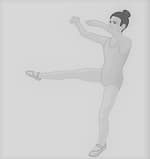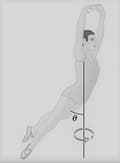In a long jump, an athlete leaves the ground with an initial angular momentum that tends to rotate her body forward, threatening to ruin her landing. To counter this tendency, she rotates her outstretched arms to "take up" the angular momentum. In , one arm sweeps through and the other arm sweeps through . Treat each arm as a thin rod of mass and length rotating around one end. In the athlete's reference frame, what is the magnitude of the total angular momentum of the arms around the common rotation axis through the shoulders?



Important Questions on Rolling, Torque, and Angular Momentum
A uniform disk of mass and radius can rotate freely about its fixed centre like a merry-go-round. A smaller uniform disk of mass and radius lies on top of the larger disk, concentric with it. Initially, the two disks rotate together with an angular velocity of . Then a slight disturbance causes the smaller disk to slide outward across the larger disk until the outer edge of the smaller disk catches on the outer edge of the larger disk. Afterwards, the two disks again rotate together (without further sliding).
(a) What then is their angular velocity about the centre of the larger disk?
(b) What is the ratio of the new kinetic energy of the two-disk system to the system's initial kinetic energy?
Figure is the overhead view of a spring lying on a frictionless surface and attached to a pivot at its right end. The spring has a relaxed length of and negligible mass. A small disk is attached to the free end at the left. The disk is then given a velocity of magnitude perpendicular to the spring's length. The disk and spring then move around the pivot.
(a) When the stretching of the spring reaches its maximum value of , what is the speed of the disk?
(b) What is the spring constant?

In the figure shown below, a bullet is fired into a block attached to the end of a non-uniform rod of mass .The block-rod-bullet system then rotates in the plane of the figure, about a fixed axis at . The rotational inertia of the rod alone about that axis at is . Treat the block as a particle. (a) What then is the rotational inertia of the block-rod-bullet system about point ? (b) If the angular speed of the system about just after impact is , what is the bullet's speed just before impact?
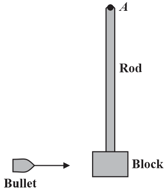
The uniform rod (length and mass ) in the figure below rotates in the plane of the figure about an axis through one end, with a rotational inertia of . As the rod swings through its lowest position, it collides with a putty wad that sticks to the end of the rod. If the rod's angular speed just before collision is , what is the angular speed of the rod-putty system immediately after collision?
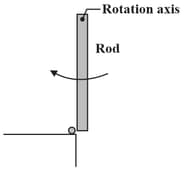
During a jump to his partner, an aerialist is to make a quadruple somersault lasting a time . For the first and the last quarter-revolution, he is in the extended orientation shown in the below figure, with rotational inertia around his center of mass (the dot). During the rest of the flight, he is in a tight tuck, with rotational inertia . What must be his angular speed around his center of mass during the tuck?
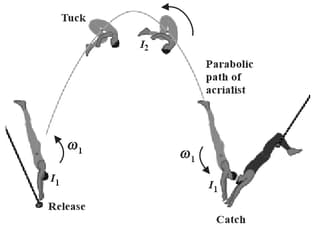
In the figure shown below, a child stands on the edge of a stationary merry-go-round of radius . The rotational inertia of the merry-go-round about its rotation axis is . The child catches a ball of mass thrown by a friend. Just before the ball is caught, it has a horizontal velocity of magnitude at an angle with a line tangent to the outer edge of the merry-go-round, as shown. What is the angular speed of the merry-go-round just after the ball is caught?
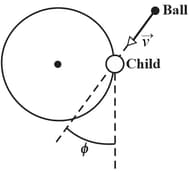
A ballerina begins a tour jeté with angular speed and a rotational inertia consisting of two parts: for her leg extended outward at an angle of to her body and for the rest of her body (primarily her trunk). Near her maximum height, she holds both legs at an angle of to her body and has an angular speed of . Assuming that has not changed, what is the ratio of ?
